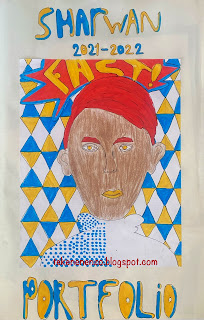Made by Tyra, grade 6
You need:
- white drawing sheet A4 size
- aquarelle pencils
- jar with water
- brush
- fine black marker
Rene Magritte is born in 1898 in Belgium. When Magritte is 13 years old, his mother commits suicide. She jumps in the river Samber and is found with her dress covering her face. This image has been suggested as the source of several paintings from Magritte: people hiding their faces with several objects.
In 1924 Magritte became friends with members of a surrealism group in Brussels: André Breton, Joan Miró and Salvador Dalí. These artists influence Magritte's work. In the end Magritte became famous with surrealistic paintings.
Magritte gave his paintings a realistic effect of surrealism. He painted simple objects, like a shoe, an apple, a pipe or a tree. Magritte took these things out of their ordinary environment and placed them in a special surrounding.
One of Magritte's most famous works is "La Trahison des Images" (The Treachery of Images). This is a very realistic painting from a pipe, with the text: Ceci n'est pas une pipe (This is not a pipe). The painting is not a pipe, but rather an image of a pipe. As Magritte himself commented: "The famous pipe. How people reproached me for it! And yet, could you stuff my pipe? No, it's just a representation, is it not? So if I had written on my picture 'This is a pipe,' I'd have been lying!" By putting us constantly on the wrong track, Magritte forces us to think about art. Magritte thought it the task of an artist to place reality in a different context.
Links:
Magritte museum, Brussel See also the other lesson
In the style of René Magritte (1) on this blog.
Made by Debbie, grade 6
Students draw a part of a man or woman, from about chest height. Like Magritte, we see no face. And, like Magritte, the person has something on his head. In stead of the face, students draw an object of their choice. The drawing, person and background, has to be coloured with aquarelle pencils. Use water and a brush to create the effect of aquarel paint. Wait until the artwork is dry and outline everything with a fine marker.























.jpg)

.jpg)
.jpg)
.jpg)
.jpg)
.jpg)
.jpg)

.jpg)







.jpg)
.jpg)

+(2).jpg)
+(2).jpg)




.jpg)
.jpg)
.jpg)
.jpg)
